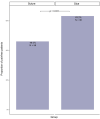Glued suture-less peritoneum closure in laparoscopic inguinal hernia repair reduces acute postoperative pain
- PMID: 38782992
- PMCID: PMC11116422
- DOI: 10.1038/s41598-024-62364-w
Glued suture-less peritoneum closure in laparoscopic inguinal hernia repair reduces acute postoperative pain
Abstract
Inguinal hernia repair is performed more than 20 million times per annum, representing a significant health and economic burden. Over the last three decades, significant technical advances have started to reduce the invasiveness of these surgeries, which translated to better recovery and reduced costs. Here we bring forward an innovative surgical technique using a biodegradable cyanoacrylate glue instead of a traumatic suture to close the peritoneum, which is a highly innervated tissue layer, at the end of endoscopy hernia surgery. To test how this affects the invasiveness of hernia surgery, we conducted a cohort study. A total of 183 patients that underwent minimally invasive hernia repair, and the peritoneum was closed with either a conventional traumatic suture (n = 126, 68.9%) or our innovative approach using glue (n = 57, 31.1%). The proportion of patients experiencing acute pain after surgery was significantly reduced (36.8 vs. 54.0%, p = 0.032) by using glue instead of a suture. In accordance, the mean pain level was higher in the suture group (VAS = 1.5 vs. 1.3, p = 0.029) and more patients were still using painkillers (77.9 vs. 52.4%, p = 0.023). Furthermore, the rate of complications was not increased in the glue group. Using multivariate regressions, we identified that using a traumatic suture was an independent predictor of acute postoperative pain (OR 2.0, 95% CI 1.1-3.9, p = 0.042). In conclusion, suture-less glue closure of the peritoneum is innovative, safe, less painful, and possibly leads to enhanced recovery and decreased health costs.
© 2024. The Author(s).
Conflict of interest statement
The authors declare no competing interests.
Figures
Similar articles
-
Comparing suture with N-Hexyl Cyanoacrylate glue for mesh fixation in inguinal hernia repair, a randomised clinical trial.Am J Surg. 2021 Jul;222(1):203-207. doi: 10.1016/j.amjsurg.2020.10.029. Epub 2020 Nov 6. Am J Surg. 2021. PMID: 33183752
-
Laparoscopic Injection of Tissue Adhesives for Inguinal Hernia Repair in a Rabbit Model: Results of an Experimental Comparative Study with the Standard Laparoscopic Inguinal Hernia Repair.J Laparoendosc Adv Surg Tech A. 2020 Jul;30(7):847-853. doi: 10.1089/lap.2020.0015. Epub 2020 May 8. J Laparoendosc Adv Surg Tech A. 2020. PMID: 32384247
-
Is it possible to eliminate sutures in open (Lichtenstein technique) and laparoscopic (totally extraperitoneal endoscopic) inguinal hernia repair? A randomized controlled trial with tissue adhesive (n-hexyl-α-cyanoacrylate).Surg Innov. 2014 Dec;21(6):590-9. doi: 10.1177/1553350613517944. Epub 2014 Jan 7. Surg Innov. 2014. PMID: 24398761 Clinical Trial.
-
Meta-analysis of glue versus sutured mesh fixation for Lichtenstein inguinal hernia repair.Br J Surg. 2013 May;100(6):735-42. doi: 10.1002/bjs.9072. Epub 2013 Feb 22. Br J Surg. 2013. PMID: 23436683 Review.
-
Fibrin versus cyanoacrylate glue for fixation in laparoscopic inguinal hernia repair: a network meta-analysis and indirect comparison.Hernia. 2020 Oct;24(5):927-935. doi: 10.1007/s10029-019-02072-x. Epub 2019 Nov 26. Hernia. 2020. PMID: 31773552
References
-
- Ger R. Laparoscopic hernia operation. Chirurg. 1991;62:266–270. - PubMed



